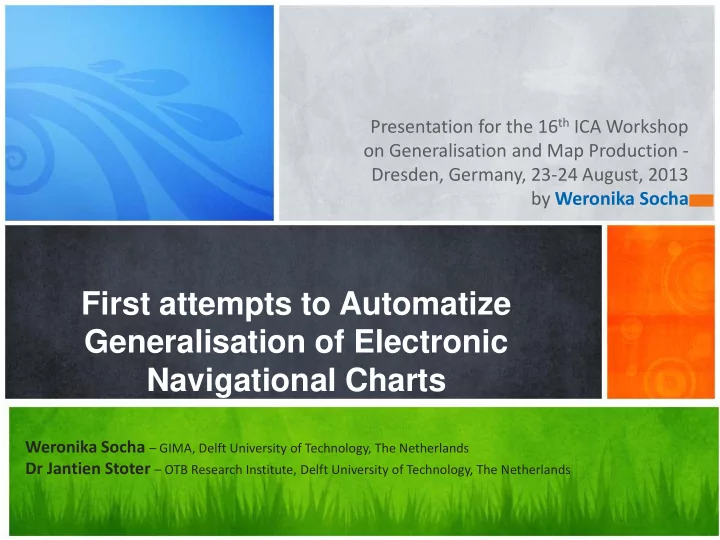

Presentation for the 16 th ICA Workshop on Generalisation and Map Production - Dresden, Germany, 23-24 August, 2013 by Weronika Socha First attempts to Automatize Generalisation of Electronic Navigational Charts Weronika Socha – GIMA, Delft University of Technology, The Netherlands Dr Jantien Stoter – OTB Research Institute, Delft University of Technology, The Netherlands
GETTING INTO THE TOPIC How are ENCs different from topographic maps? What is the project about? 2
Fun facts about ENCs • One data model!!! • Object oriented approach (170/190) • No presentation concerns (S-52) – No labels • No aesthetics (almost) • Everyone has to use it (by 2018) • Straightforward user requirements 3
• Points, Lines, Areas and Soundings • Geo, Meta, Collection (and Cartographic) Source: CARIS B.V. • ‘Skin of the Earth’ and others • 3 display levels (Base, Highly simplified data model Standard, All) • Developments take place 4
S-57 Data Model: Points • Feature Objects may share Spatial Objects TOPMAR BCNCAR LIGHTS Source: CARIS B.V. Feature Objects Spatial Objects 55.35 º N 12.41 º E
S-57 Data Model: 2. Soundings (cont) • Soundings with identical attribute values can be grouped into one Feature Object – Result is more efficient storage of sounding data SOUNDG Source: CARIS B.V. Feature Objects Spatial Objects X , Y , Z , X , Y , Z X , Y , Z, …..... 5 9 8 6 2 3 3 4 7 4 7 5 6 2 8 1
Example of an object class Add more 7
Scales 8
Different experience…? 9
Problem • No efficient specifications or tools for the automatic generalisation of S-57 data. • Direct translation of generalisation principles not satisfactory as ENC imperatives are different. • Safety of navigation condition inexistent among common generalisation methods. 10
RESULTS Specifications Maps Evaluation 11
Aids to Navigation Cardinal or SELECT all Isolated Masters AND Slaves Danger < 2Nm from Surrounded Do not Main land by land select SELECT all Other On water Light Masters AND Not Slaves SELECT all surrounded ≥ 2Nm from Masters AND Do not by land Main land No light Slaves select AtoNs SELECT all BCN* Masters AND Slaves SELECT all On land Light Masters AND Slaves SELECT all LNDMRK Conspicuous Masters AND Slaves No light Not Do not conspicuous select 12
Land area Point Do not select Another LNDARE LNDARE (area) Aggregate Smooth within 50m Collapse into Area Smaller than point and 1mm/cs SELECT Smooth SELECT 13
Build-up areas Convert into BUISGL BUAARE Another BUAARE within Aggregate Simplify 3mm/cs BUAARE Small Do not select Simplify SELECT 14
Object group What was done? What went well? What went wrong? Not all support structures Selection Safe approach chosen AtoNs and Landmarks De-clustering Logical selection Manual effort still needed for special cases Possibly manual deletions WRECKS Selection All selected correctly involved Selection UWTROC Safe approach Clusters of objects Removing redundant Aggregation Time savings Generalisation not on the LNDARE Simplification Effective depiction of small safe side Oversimplification Collapsing islands Create feature based on geometry Time savings COALNE Short edges Buffers Correct attribution Assignation of attributes No differentiation between close to shore and far from Aggregation BUAARE Correct shape shore Simplification Need to take more objects into account No OBSTRN points Safe approach Clusters of other objects on OBSTRN Enlargement Effective depiction better scale should be Consistent with Approach transformed into OBSTRN areas on the target chart 15 Miscellaneous Selection Sometimes time savings Difficult to find patterns
Brazil 16
France 17
New Zealand 18
The Netherlands 19
General comments • France – “very encouraging to see the results ” – “in this area of marine cartography that we lack appropriate tools” – “it is necessary to move the objects "seaward"” – “generalisation should be holistic (more complex) and not theme by theme” • New Zealand – “land area and coastline not completely desirable” – “the routines for de-cluttering of point objects interesting and with a bit of tweaking could be implemented quite quickly” • The Netherlands – “results look promising” – “it is a pity that the bathymetry was not generalised, because generalisation of bathymetry is a recurring event” 20
PROBLEMS & LIMITATIONS 21
Selected issues • Data quality • Standardization • Long distance cooperation • What is good? • Not complex approach (bathymetry) 22
Open questions • How to model ‘safety of navigation’ and propagate uncertainty information? • Holistic approach? – Bathymetry determines all – Objects interact – Meta, Collection objects affected 23
Ques Qu estions ns? Presentation for the 16 th ICA Workshop on Generalisation and Map Production - Dresden, Germany, 23-24 August, 2013 by Weronika Socha First attempts to Automatize Generalisation of Electronic Navigational Charts Weronika Socha – GIMA, Delft University of Technology, The Netherlands Dr Jantien Stoter – OTB Research Institute, Delft University of Technology, The Netherlands
Recommend
More recommend